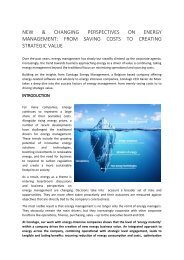Accurate Allocation of energy in production processes - the importance of using metamodels
Many companies struggle with correctly monitoring, allocating and distributing direct and indirect energy consumption over all internal and external customers, users or products. In this age of rising commodity costs and additional attention to sustainability, the advantages of adequately allocating energy are nonetheless substantial: 1. Real-time mapping of energy throughout process flows makes it easier to detect deviations in energy conversions during production processes, find the root causes and reduce losses. 2. Using exact and objective keys for allocating energy consumption speeds up periodic P&L and CSR reporting and makes for more accurate reports. 3. Continuous, real-time distribution of energy cost among users increases transparency and raises awareness with them. Although most companies already struggle with integrating correct data from metered equipment, this is only the first - albeit important - step. The crux is fully understanding the nature and efficiency of energy conversions processes; energy inflows and outflows to different customers; fixed and variable costs and corporate structures. By using metamodels - designed for and maintained by energy managers - all this information is added to the initial metered data and processed in such a way that any change from an energy point of view instantly leads to adjustments in the energy allocation. This white paper reviews emerging trends and challenges in energy allocation and examines the working and benefits of using specific metamodels at the level of energy management software.
Many companies struggle with correctly monitoring, allocating and distributing
direct and indirect energy consumption over all internal and external customers,
users or products. In this age of rising commodity costs and additional
attention to sustainability, the advantages of adequately allocating energy are
nonetheless substantial:
1. Real-time mapping of energy throughout process flows makes it easier
to detect deviations in energy conversions during production processes,
find the root causes and reduce losses.
2. Using exact and objective keys for allocating energy consumption
speeds up periodic P&L and CSR reporting and makes for more accurate
reports.
3. Continuous, real-time distribution of energy cost among users increases
transparency and raises awareness with them.
Although most companies already struggle with integrating correct data from
metered equipment, this is only the first - albeit important - step. The crux is
fully understanding the nature and efficiency of energy conversions processes;
energy inflows and outflows to different customers; fixed and variable costs
and corporate structures. By using metamodels - designed for and maintained
by energy managers - all this information is added to the initial metered data
and processed in such a way that any change from an energy point of view
instantly leads to adjustments in the energy allocation.
This white paper reviews emerging trends and challenges in energy allocation
and examines the working and benefits of using specific metamodels at the
level of energy management software.
Create successful ePaper yourself
Turn your PDF publications into a flip-book with our unique Google optimized e-Paper software.
commodity costs, like depreciation costs, operational costs and ma<strong>in</strong>tenance,<br />
to <strong>the</strong> <strong>in</strong>ternal customers. A graph-based model which <strong>in</strong>cludes commodity<br />
conversions will be very helpful <strong>in</strong> implement<strong>in</strong>g this application.<br />
All <strong>in</strong> all, three steps are needed to correctly allocate commodity costs to a<br />
company’s <strong>in</strong>ternal customers.<br />
Assign<strong>in</strong>g cost centers<br />
The first step <strong>in</strong> build<strong>in</strong>g a cost allocation application model is to assign cost<br />
centers to all nodes <strong>in</strong> <strong>the</strong> graph based model. Four types <strong>of</strong> nodes exist <strong>in</strong><br />
<strong>the</strong> graph model: source nodes, conversion nodes, distribution nodes and s<strong>in</strong>k<br />
nodes.<br />
Source nodes apply to acquired commodities on <strong>the</strong> one hand and locally<br />
generated ones on <strong>the</strong> o<strong>the</strong>r (e.g. electricity from w<strong>in</strong>d turb<strong>in</strong>es or solar plants).<br />
For acquired commodity types <strong>the</strong> monthly <strong>in</strong>voices will be assigned to <strong>the</strong>ir<br />
cost centers. For locally generated commodity types, <strong>the</strong> depreciation costs,<br />
operational costs and ma<strong>in</strong>tenance costs will be assigned.<br />
Conversion nodes are used for <strong>in</strong>dustrial <strong>in</strong>stallations which convert one or more<br />
commodity types <strong>in</strong>to o<strong>the</strong>rs. A typical example would be <strong>the</strong> conversion <strong>of</strong><br />
natural gas <strong>in</strong>to heat, which is distributed across <strong>the</strong> site via a pipel<strong>in</strong>e network<br />
<strong>of</strong> superheated pressurized water. The costs for <strong>the</strong> conversion <strong>in</strong>stallation like<br />
depreciation costs, operat<strong>in</strong>g costs and ma<strong>in</strong>tenance costs are assigned to<br />
<strong>the</strong>ir cost center.<br />
Distribution nodes are used to bundle all <strong>the</strong> sources <strong>of</strong> a s<strong>in</strong>gle commodity<br />
type and distribute <strong>the</strong> commodity among <strong>the</strong> o<strong>the</strong>r conversion, s<strong>in</strong>k or<br />
distribution nodes <strong>of</strong> <strong>the</strong> same type. Even when distribution nodes for <strong>the</strong><br />
same commodity type form a hierarchy, cost allocation is no problem as long<br />
as all <strong>the</strong> distribution nodes <strong>of</strong> <strong>the</strong> same type have <strong>the</strong> same cost center.<br />
Depreciation costs and ma<strong>in</strong>tenance costs for <strong>the</strong> distribution network on <strong>the</strong> site<br />
can be assignedto<strong>the</strong>ircostcenter. Typically<strong>the</strong>distributionnodewillalsodealwith<br />
losses<strong>in</strong> <strong>the</strong> distribution network which represent a cost. These losses will be<br />
distributed to <strong>the</strong> s<strong>in</strong>k nodes accord<strong>in</strong>g to <strong>the</strong>ir usage, ensur<strong>in</strong>g <strong>the</strong>se loss costs<br />
will be assigned to <strong>the</strong> <strong>in</strong>ternal customers automatically.<br />
For example a site converts natural gas and water <strong>in</strong>to steam. This steam is<br />
distributed over <strong>the</strong> site via a pipel<strong>in</strong>e network. This pipel<strong>in</strong>e network represents<br />
an <strong>in</strong>vestment which is depreciated on a regular <strong>in</strong>terval and will also require<br />
ma<strong>in</strong>tenance. Pipes corrode and need replac<strong>in</strong>g or valves break down and need<br />
replacement as well. T<strong>in</strong>y leaks <strong>in</strong> <strong>the</strong> pipel<strong>in</strong>e network cause pressure drops<br />
and represent losses. All <strong>the</strong>se costs are addressed by <strong>the</strong> distribution node.<br />
20




